Written by jointly by Randy and Laurie Gaulke (First published in https://meuse-argonne.com in August 2019.)
Introduction
After spending eight months in France in 2017-18, helping Americans rediscover the footsteps of their ancestors, it was time for Webmaster Randy Gaulke and family to retrace the footsteps of Laurie’s uncle, 1st Lt. Laurence R. “Ronnie” MacDonnell, who was a USAAF fighter pilot and who was killed German FLAK near Mortain France on 9 August 1944–just weeks after the Normandy Landings. During the weekend of 7-10 June 2019 a small, local French Association treated the Gaulke family like royalty, organizing a vin d’honneur, two days of coach tours, a flight over the crash site, and the presentation of a shadow box containing pieces of Ronnie’s wrecked plane. The three of us, especially Laurie, have been extremely moved by the outpouring of hospitality from our French hosts. Even today–six weeks after the activities–it is hard to verbalize our feelings of gratitude for our new-found French friends! We hope that you enjoy this story of commemoration and bridging cultures.
The Email that Started it All
Sometime in the first half of 2018 Laurie and (son) Graham received an email from Frenchman Thierry Houstin. He wrote: “I am a volunteer with the Michael Burik Association, a non-profit French organization. Michael Burik was an American soldier who died for France in 1944… For the 75th Anniversary of D-Day in June 2019, we would like to gather together as many descendants… of soldiers who died for France near [the town of] Mortain…” Thierry had identified Laurie and Graham as relatives of Laurence R. MacDonnell, but we had no idea what Laurence did in WW2. Nevertheless, we were intrigued enough to commit to attending the Commemoration.
Beginning in late 2018 / early 2019 we researched his pre-war and war-time life to the extent that we could. Using resources such as the only surviving brother, the National Archives, and the Lawrence, MA Public Library and High School, we were able to paint a picture of his life. Thus by the time we left in early June, we felt we had “rediscovered” Ronnie. A summary of Ronnie’s life can be found here:
Comments on Laurence MacDonnell
“As the youngest of 5 children with a 15-year span between me and my oldest sister, I had no idea who this ‘uncle’ was. Since my father died when I was 12, I wasn’t privy to any family mentions of his brother. All I recall of Ronnie was one photo I received after one of my sisters passed away. To receive that email was, for me, a history lover, the only push I needed to go down the research rabbit hole. I was so moved by Ronnie’s graduation photo with his entire class and by another photo with him and my dad, both in their smart uniforms, with my grandmother. It was time to breathe life back into this young man!”
During the same period we remained in contact with Thierry, who constantly hinted that he and the Association had some wonderful surprises in store for us.
Day 1: Jet-lag and the Vin d’honneur
Our Aer Lingus flight landed at CDG (Paris) in the late morning hours of 7 June. We picked up the rental car and started the four plus hour drive to Normandy, where we were supposed to meet Graham, who was already in the region with some French reenactors. Rendezvous point: The Overlord Museum in Colleville-sur-Mer. That was a big mistake: Roads were packed with people for the 75th Anniversary. By the time we met up it was late afternoon. We still had a two-hour drive south to St. Barthélemy (near Mortain), where the Association and the local mayor had arranged a vin d’honneur. We pulled into town at 18h05–just five minutes late. We had not yet been to our rental cottage to check in or to freshen up. Somehow we survived the introductions and the toast. The introductions included an American family of five from Utah–the descendants of Fred Wrotin, 30th Inf. Division, who died on 8 August 1944. Dead to the world, we left for our rental cottage around 19h30; having been informed that the coach would depart St. Barthélemy at 08h30 Saturday morning. Figuratively speaking, for us it was the longest day.
“Many of the photos from that reception show us almost as zombies, lol. Jumping right into speaking French, reuniting with Graham after many months, beyond jet lagged, suddenly in the spotlight, was surreal… This was just the beginning.”
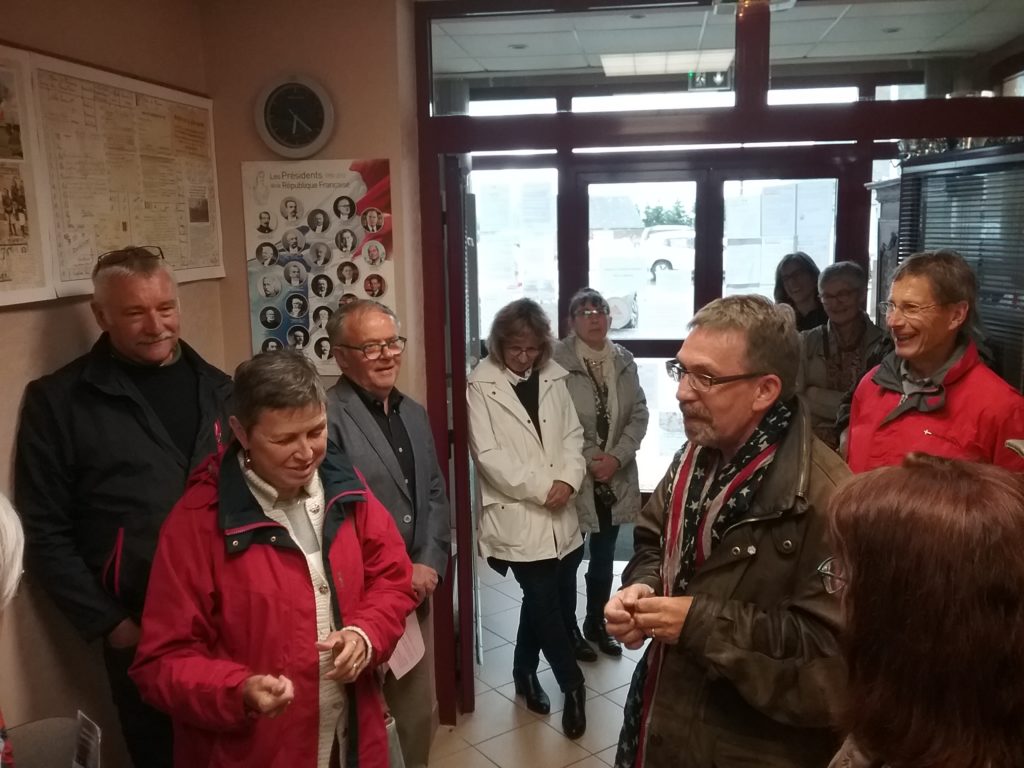
Friday’s Vin d’honneur. Photo Credit: Amelie Houstin
Day 2: Bus Tour to Normandy Beaches and Points in Between
Still exhausted, we arrived at the Mairie (town hall) on time and boarded a large coach bus. Participants included the two American families, members of the Association and members of the general public. During the 90-minute drive to Omaha Beach on the Normandy Coast we stopped at several points of WW2 interest, lined up then and now photos, and listened to presentations on the history of those sites. The day included a visit to the Normandy American Cemetery and lunch at a restaurant on Omaha Beach. Fred Wrotin’s Division had come ashore at Omaha Beach just a few days after 6 June.
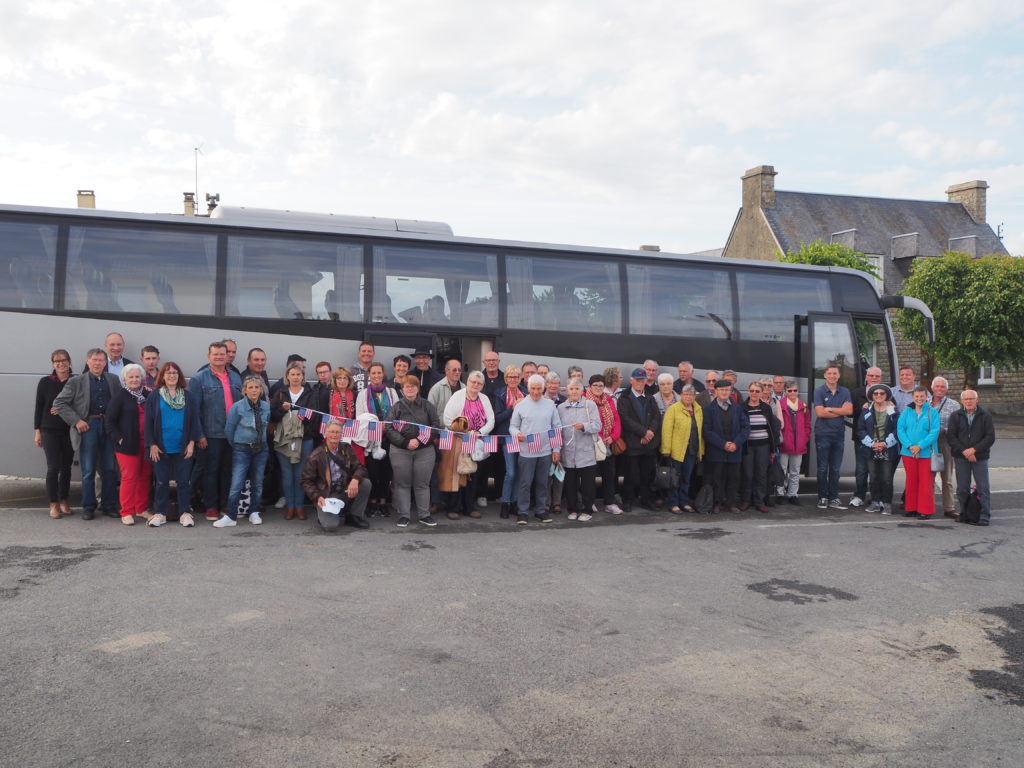
Saturday Bus and Participants. Photo Credit: Amelie Houstin
During all of this the members of the Association went above and beyond to make us feel welcome. They engaged Isy Martin, a local French woman who had lived in England, to act as translator and interpreter. What a wonderful job she did! Laurie and I speak relatively good French, but the other Americans did not speak any French. Association President, Philippe Levesque, also presented Graham (age 20) and Jack Wirick (age 17) with commemoration pins; emphasizing that they must continue to remember and they must return in 2044 for the Centennial.
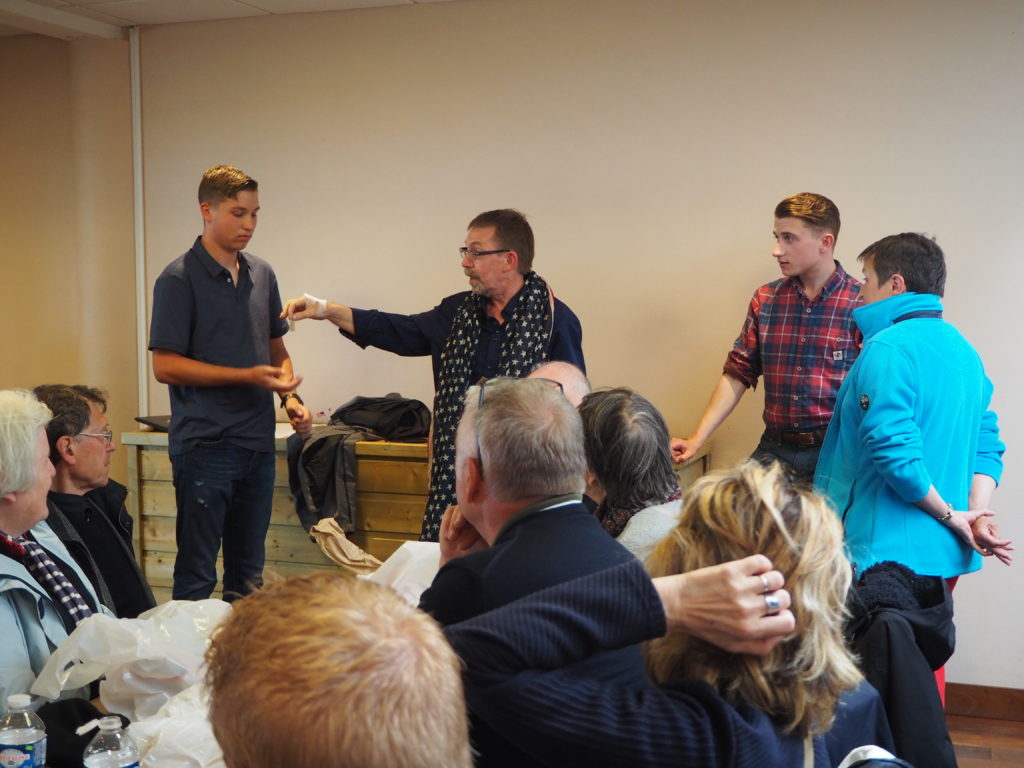
Jack (L) and Graham (R) Receiving Their Commemorative Pins from President Levesque. Photo Credit: Amelie Houstin
“It truly is the next generation who will ensure that such a horrific war never occur again. Again, weepy eyed at lunch as Graham and Jack received their great commission. They’d better return in 2044 — heck, Randy and I are planning on it.”

The Beauty of Omaha Beach Today. Photo Credit: Laurie Gaulke
The return to Saint Barthélemy was similar in structure. Then came dinner out. Again, the members of the Association went out of their way to make us feel welcome. They would not even allow us to pay for our dinners!
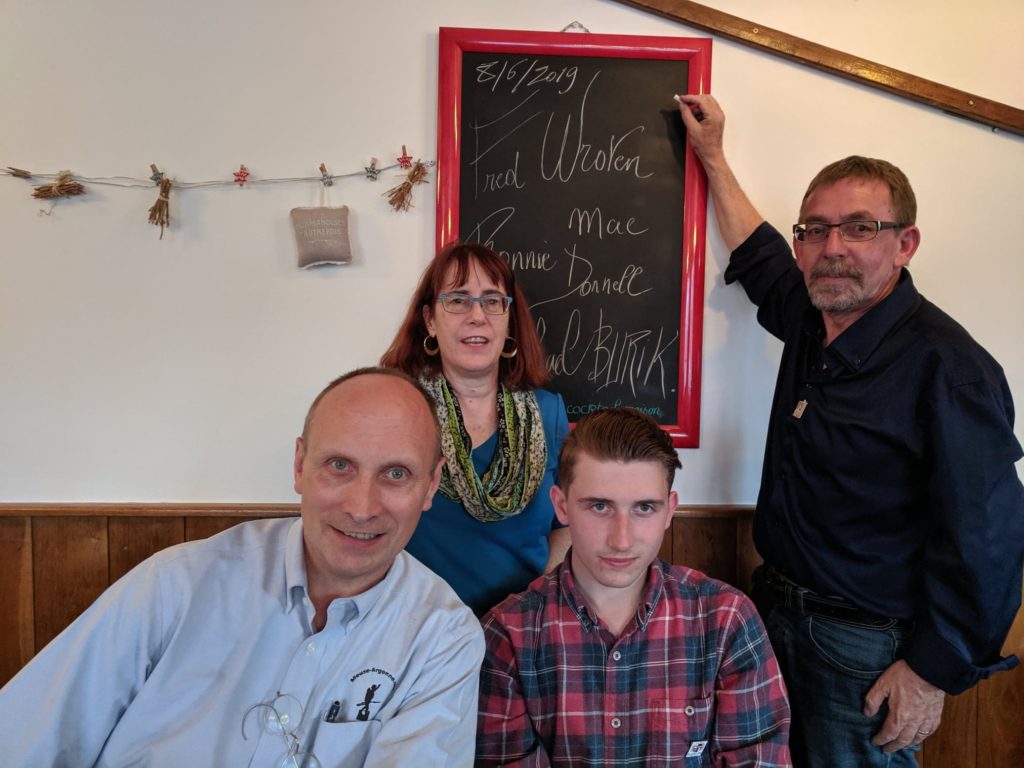
President Philippe Levesque and the Gaulke Family at Dinner. Photo Credit: Amelie Houstin
Day 3: Ronnie’s Commemoration Ceremony
Sunday, 9 June was similar in structure; but we stayed closer to Mortain. The fighting around Mortain, France reached its zenith in early August, when Hitler’s forces counter-attacked to stop the Allied advance. For us, Sunday would be the most emotional day.
“I was alerted that Sunday was ‘my day,’ so I made sure to pack extra tissues.”

The Gaulke Family on the way to Ronnie’s Crash Site. Photo Credit: Amelie Houstin
After the morning tour and lunch we were seated in a WW2-era jeep and driven to the site where 1st Lt. Laurence R. MacDonnell crashed on 9 August 1944. The Association held a commemoration ceremony there that included the Mayor of Ger, France, a bugler who played taps and the Star-Spangled Banner and flag bearers. They also presented us with a shadow box containing pieces of Ronnie’s aircraft that a local citizen must have collected seventy-five years ago. Except for Thierry’s hints, we had no idea that the Association would go to such length to remember Laurie’s uncle.
“It is impossible to put into words… I kept saying… who the heck gets to do this? I felt like a VIP, albeit one who kept crying. It’s so odd in a way that I was so very emotional about a man I never knew. I suppose Ronnie represented all the brave young men who gave up their lives for a cause and an outcome they wouldn’t know. And of course he was a beloved son of my grandparents. I never knew how they felt getting the official news of his death; with my dad also overseas, I can’t even imagine the sleepless nights. So. Many. Young. Men. Taps was the ‘worst’ part as that haunting single trumpet played by a young man my son’s age. I looked up into that blue sky and simply said to myself “Ronnie, I hope you know how much you are remembered, loved and admired.”
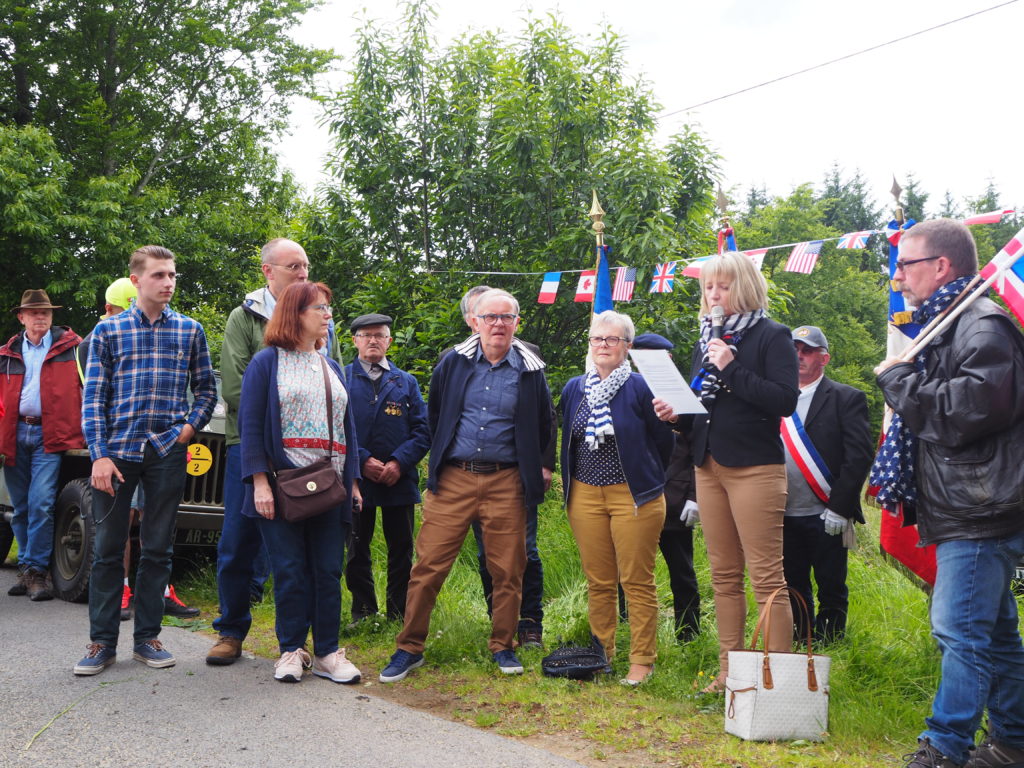
The Mayor of Ger, France Speaking at Ronnie’s Crash Site. Photo Credit: Amelie Houstin
Again, we had dinner with the Association and they would not let us pay. At the end of the day we were instructed where to meet Thierry and Claude Compagnon early Monday morning for yet another experience.
Day 4: The Fly-over
Thierry and Claude drove us to a local airfield where we boarded a sport plane and few over the crash site in Ger, France. Once again, the Association arranged for this and it would not let us pay any of the cost.
“My first ever flight in a Cessna. I’ve gotten very good at French humor… before we took off, the airport manager told me very seriously, yet with a smile, that if we should get into any trouble, I was to raise my left hand so he could see it. he paused and asked me if I knew why. I said ‘non.’ He laughed and said “That is so I can see your watch and can take it off your wrist.” I was able to quickly respond in French that as I no longer wear a watch to tell the time, I’d be sure to pull out my cell phone.
The countryside laid out below like a gorgeous green patchwork of farms, fields, homes. Hard to get my bearings on the spot where Ronnie fell… unimaginable 75 years ago in a barrage of German anti-aircraft guns… was Ronnie scared? What were his last thoughts? I simply kept looking out over the French countryside. A good thing I carried more tissues! And then afterwards doing an interview in French for two papers–another first.”
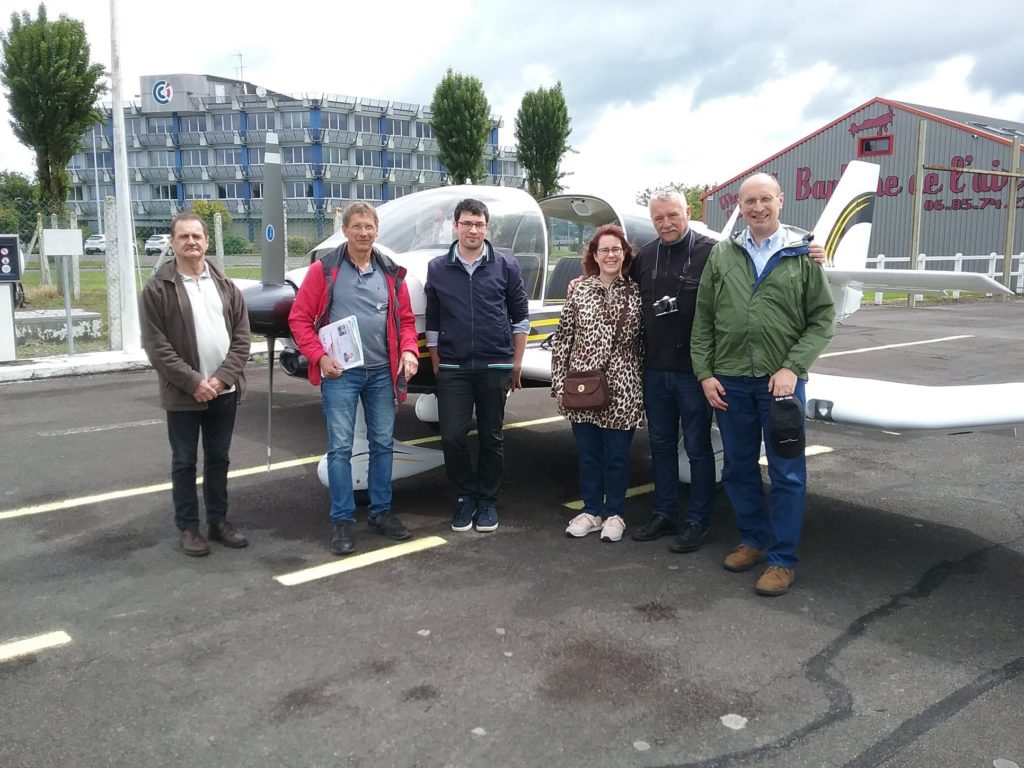
At the Airport with New-Found Friends: Airport Operator, Claude Compagnon, Pilot, Laurie Gaulke, Thierry Houstin and Randy Gaulke. Photo Credit: ??
This was a beautiful end to a beautiful commemoration ceremony organized by the Association Soldat Michael Burik. President Philippe Levesque, members Thierry Houstin and Claude Compagnon, interpreter Isy Martin and her husband David and many others went out of their way to commemorate the actions of two Americans who died in the liberation of France. They also went out of their way to make the descendants of those soldiers feel at home during the commemoration. We would remain in Normandy for several days, visiting sites on our own. But we continue to feel overwhelmed at the effort the Association made on our behalf. What a wonderful trip!
The Dark Side of the Story
One of the reasons we are writing the summary is to convince and encourage Americans to be open to cultural exchanges such as this trip. Stereotypes aside, most French are extremely thankful for the role that Americans played in the liberation of France in WW1 and WW2; but language barriers may prevent them from expressing it eloquently. Nevertheless, the commemoration of events surrounding the 75th Anniversary of the Normandy Landing (2019) and the 100th Anniversary of WW1 (2014-18) have demonstrated their continued gratitude toward Americans.
The leaders and members of the Association Soldat Michael Burik–especially Mr. Thierry Houstin–spent the last two years identifying and researching more than 1,500 American soldiers killed in a 20km (12 mile) radius of Mortain. They found 1,800 family members (using sources like Ancestry.com and Findagrave.com) and they sent out approximately 800 emails. They received 50 responses, but in the end only two American families participated in the commemoration. We understand that there are many reasons to say no: age, health, income, lack of vacation time, etc. Yet we wonder how many families said no because of fear of traveling abroad, inability to step out of their comfort zone, or fear that this ‘commemoration’ by some small French association was in internet scam.
“What if we hadn’t said yes to that email? Imagine what we would have missed: new friendships, finally ‘meeting’ my uncle, experiences beyond our imaginations… who the heck gets to DO this? We do, because we stepped out in faith and goodwill. We’re hoping to make a return visit next year… there’s talk of trying to get family members of Ronnie’s squadron together. Now THAT would be incredible!”
The close relationship between the U.S. and France started during the American Revolution. It continued in WW1 and WW2. Let us hope that it continues long into the future.
For Further Reading
In 2018 Randy participated in an extremely moving Centennial celebration involving Laurie Button of Colorado and the French town of Louppy-sur-Loison. Laurie Button’s story, “When an American Woman Rediscovers the Memory of a Small Village in the Meuse” can be viewed here.
#kneedeepintohistory #meuseargonne #battlefieldtours #ww1tours #ww2tours
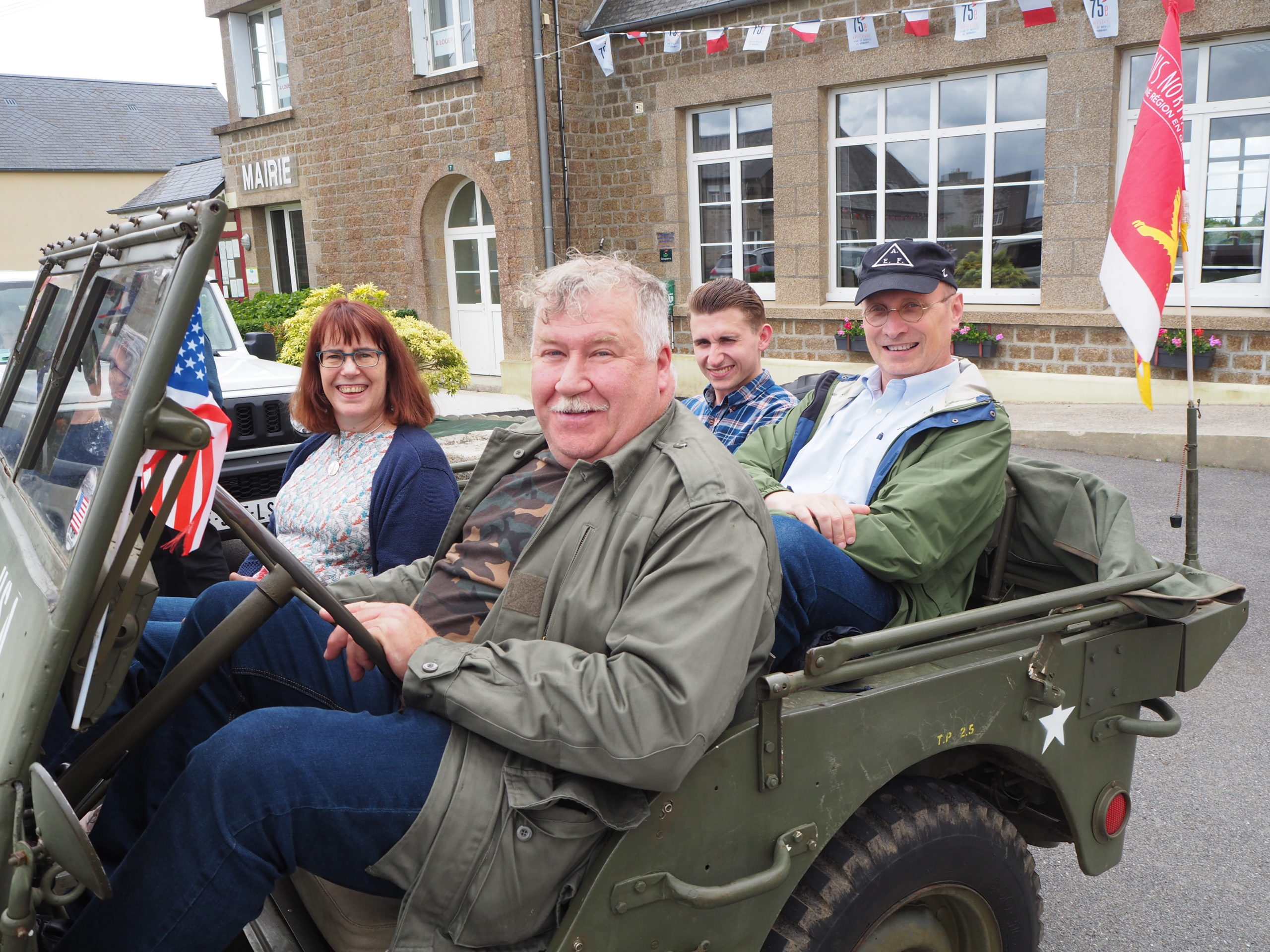
Leave a Reply